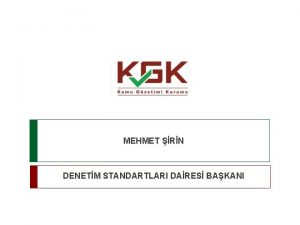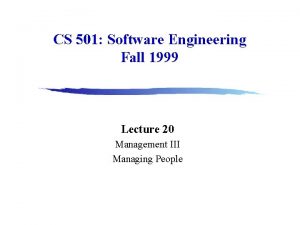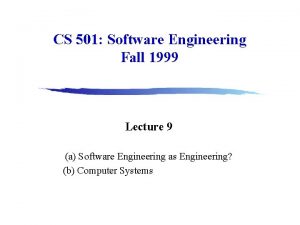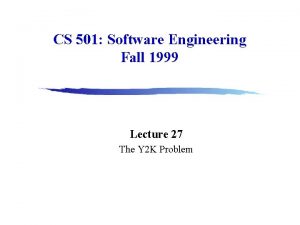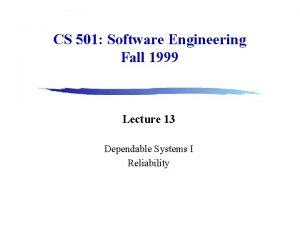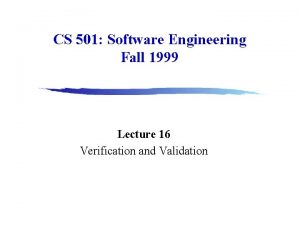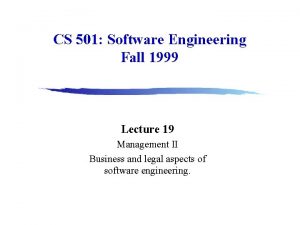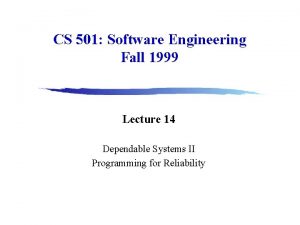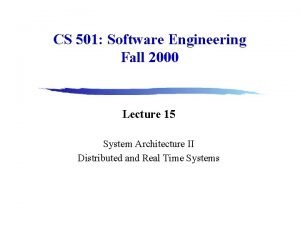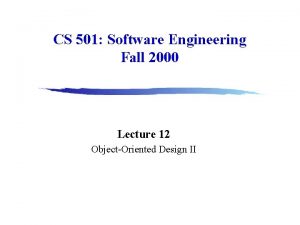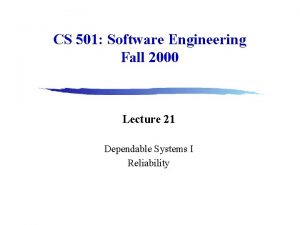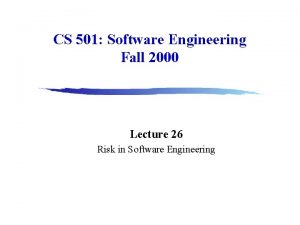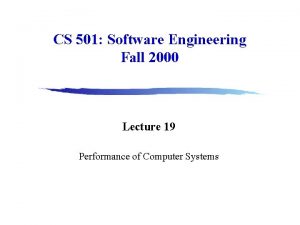CS 501 Software Engineering Fall 1999 Lecture 5



















- Slides: 19

CS 501: Software Engineering Fall 1999 Lecture 5 (a) Requirements Analysis (continued) (b) Requirements Specification

Administration Assignment 2: See "Course Notices" on web site. Recitation sessions on next two Mondays. Teaching Assistant office hours: See "Administration" on web site.

The Requirements Process Feasibility Study Feasibility Report Requirements Analysis Requirements Definition System Models Requirements Specification Definition of Requirements Document Specification of Requirements

Requirements Analysis Methods for data modeling and design Data flow diagrams Entity-relation diagrams Data dictionaries Schema Many of these methods blur the distinction between analysis and design.

Entity-Relation Model A database of entities and relations Tools for displaying and manipulating entity-relation diagrams Tools for manipulating the database (e. g. , as input to database design) Warning: There is much confusion about definitions and notation

Entity-Relation Diagram An entity A relation between entities An entity or relation attribute An inheritance relation

Example: CS 501 Project Major Client 1 Student Project 1 CS 501 Student 5 to 7 Member of 0: n Person 0: n Tech contact

Example: MARC Catalog Record Caroline R. Arms, editor, Campus strategies for libraries and electronic information. Bedford, MA: Digital Press, 1990.

MARC Format for Monographs (Books) &001 89 -16879 r 93 &245 Campus strategies for libraries and electronic information/Caroline Arms, editor. &260 {Bedford, Mass. } : Digital Press, c 1990. &300 xi, 404 p. : ill. ; 24 cm. &440 EDUCOM strategies series on information technology &504 Includes bibliographical references (p. {373}381). &020 ISBN 1 -55558 -036 -X : $34. 95 &650 Academic libraries--United States--Automation. &650 Libraries and electronic publishing--United States. &700 Arms, Caroline R. (Caroline Ruth)

Entity-Relation Diagram for MARC Book 0: n 1 0: n Describes 0: n Catalog record Short title 1: n Author of Editor of Is about Control numb 0: n Creator 0: n Subject heading

Data Dictionaries A data dictionary is a list of names used by the system Brief definition (e. g. , what is "date") What is it (e. g. , number, relation) Where is it used (e. g. , source, used by, etc. ) May be combined with a glossary As the system is implemented, the data dictionary in the requirements is input to the system data dictionary, which is a formal part of the system specification.

Non-Functional Requirements Product requirements performance, reliability, portability, etc. . . Organizational requirements delivery, training, standards, etc. . . External requirements legal, interoperability, etc. . .

Non-Functional Requirements Examples: Privacy: Andrew system Minimizing records: Ne. XT Audit trails and long-term archiving Sales and marketing: New England Digital

Unspoken Requirements Example: Resistance to change at XXX

Requirements Specification What is the purpose of the Requirements Specification?

Requirements Specification: Purpose 1. It describes the requirements to the stakeholders Expressed in the terms that the stakeholders understand Comprehensible from many viewpoints Reviewed by stakeholders so that they understand implications Must be clear about assumptions (things left out)

Requirements Specification: Purpose 2. It describes the requirements to the implementers As precise and specific as possible Expressed in terms that they understand Comprehensible to new team members 3. It records the requirements for the future An essential part of system evolution 4. If may be a contractual document See you in court!

Requirements Specification: Approaches Natural language Structured natural language Design description language Requirements specification language Graphical notation Formal specification See Sommerville, Chapter 7.

Reading Before next class, read and be ready to discuss: Sommerville: Chapters 9 and 10 pages 157 to 170.
 Software engineering lecture notes
Software engineering lecture notes 01:640:244 lecture notes - lecture 15: plat, idah, farad
01:640:244 lecture notes - lecture 15: plat, idah, farad Computer based system engineering in software engineering
Computer based system engineering in software engineering Forward engineering in software engineering
Forward engineering in software engineering Software maintenance process models ppt
Software maintenance process models ppt Frank maurer
Frank maurer What is software metrics in software engineering
What is software metrics in software engineering Software engineering crisis
Software engineering crisis Software measurement and metrics in software engineering
Software measurement and metrics in software engineering Real time software design in software engineering
Real time software design in software engineering Design principles in software engineering
Design principles in software engineering Financial engineering lecture notes
Financial engineering lecture notes Foundation engineering lecture notes
Foundation engineering lecture notes Descriptive ethics
Descriptive ethics Ponderatie onderwijs
Ponderatie onderwijs Rimskych 501
Rimskych 501 Bds 501
Bds 501 Somos um pequeno povo mui feliz
Somos um pequeno povo mui feliz Eng m 501
Eng m 501 Ariane 501
Ariane 501
















